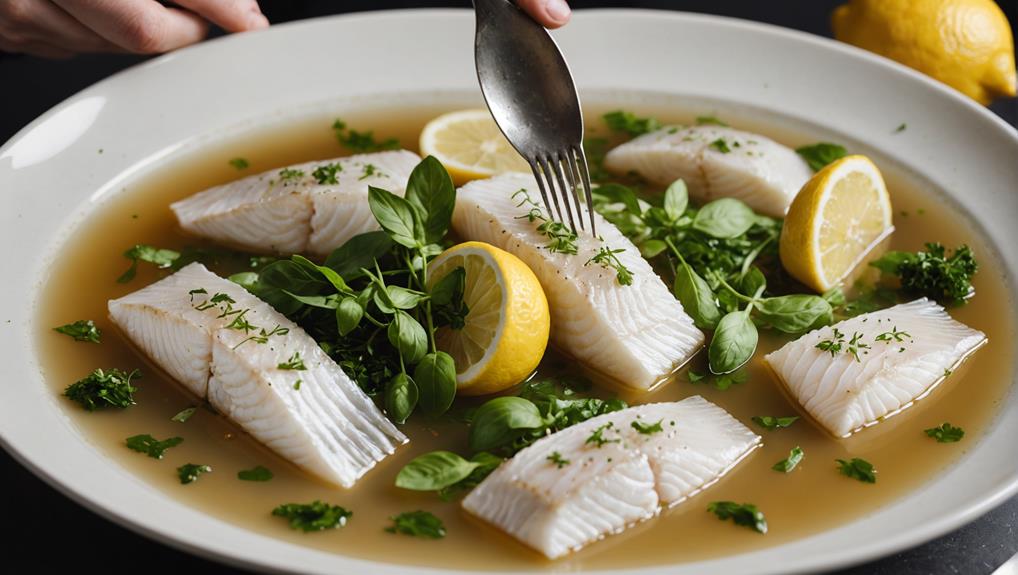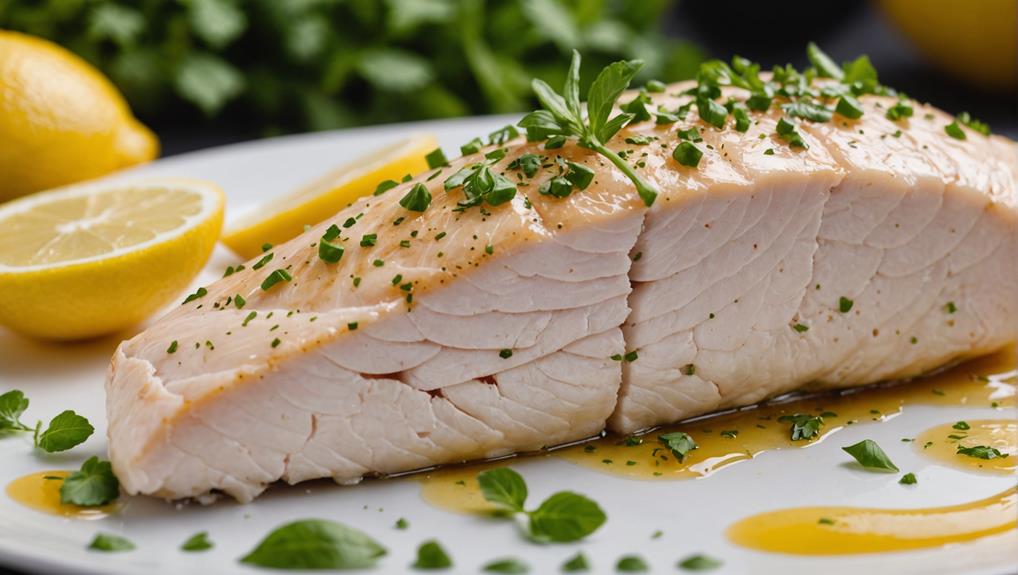To master the art of poaching fish, start with a wide, shallow pan and create a flavorful liquid base using herbs, spices, and citrus. Maintain a gentle simmer between 160°F and 180°F, avoiding stirring once the fish is added. Monitor doneness by observing texture changes and using a thermometer to reach an internal temperature of 135°F to 140°F. Enhance flavor with aromatics like dill or tarragon, and adjust cooking time based on fish thickness. When plating, use a spatula to carefully transfer the fish, and garnish with herbs for visual appeal. By mastering these techniques, you'll elevate your culinary skills and produce consistently delicate, flavorful results.
Selecting the Ideal Poaching Vessel
When it comes to poaching fish, selecting the right vessel is crucial for achieving perfect results.
You'll want to choose a wide, shallow pan or deep skillet that allows your fish to be fully submerged in the poaching liquid. This ensures even cooking and ample space for the delicate process.
Opt for a heavy-bottomed pot to distribute heat evenly, maintaining a consistent temperature throughout the poaching process. This is essential for perfectly cooked fish every time.
A tight-fitting lid is also important, as it traps steam and helps maintain the gentle simmer needed for effective poaching.
Consider using a transparent or light-colored pot to easily monitor the clarity of your poaching liquid and any aromatic ingredients you've added. This visibility allows you to make quick adjustments if needed.
Lastly, ensure that your chosen vessel is appropriately sized for the amount of fish you're cooking. Overcrowding can lead to uneven cooking, so give your fish plenty of room to poach perfectly.
Crafting the Perfect Poaching Liquid
Once you've selected the ideal vessel, it's time to focus on crafting the perfect poaching liquid. This aromatic and flavorful mixture will elevate your fish to new culinary heights. Begin with a base of water or broth, then add herbs, spices, onions, and citrus to create a rich flavor profile.
Don't forget to include acidic elements like white wine or lemon juice, which not only enhance taste but also tenderize the fish.
To ensure optimal results, keep these key points in mind:
- Maintain a temperature between 160°F and 180°F, allowing the liquid to simmer gently without boiling.
- Season generously with salt and pepper, along with your chosen flavorings.
- Consider the poaching liquid's potential for future use as a sauce or base for other recipes.
As you craft your poaching liquid, remember that innovation lies in the balance of flavors.
Experiment with unique combinations of herbs and spices to create a signature blend that sets your dish apart.
Mastering the Gentle Simmer
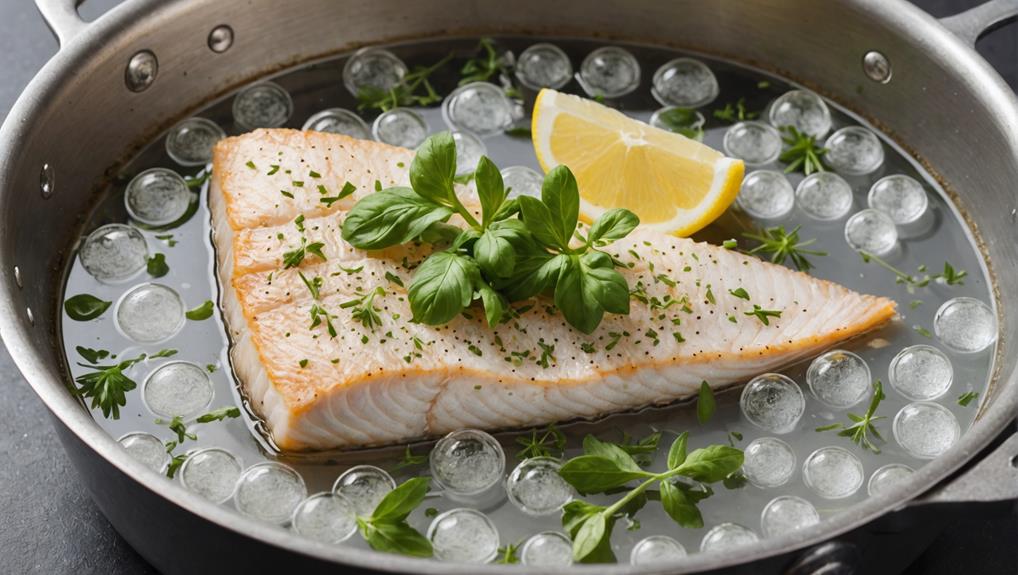
With your poaching liquid prepared, it's time to focus on the art of the gentle simmer. This crucial step ensures your fish cooks evenly and retains its delicate texture.
Begin by bringing your liquid to a boil, then immediately reduce the heat to achieve that perfect gentle simmer. You'll want to maintain a consistent temperature between 160°F and 180°F throughout the cooking process.
As you add your fish, remember that less is more when it comes to movement. Avoid stirring the liquid once the fish is in place, as this can break apart the delicate fillets. Instead, let the gentle simmer work its magic, allowing for even heat distribution and proper cooking.
For optimal results, use an instant-read thermometer to monitor your fish's internal temperature, aiming for 135°F to 140°F.
Keep in mind that thinner fillets, like flounder, should be no thicker than one inch and will cook in less than five minutes. This quick cooking time helps preserve moisture and ensures a perfectly tender result.
Gauging Fish Doneness Accurately
When poaching fish, you'll need to master both visual and temperature-based methods to ensure perfect doneness.
Look for a firm yet slightly springy texture when gently pressing the thickest part of the fish, which indicates it's cooked through but not overdone.
For precise results, you should use an instant-read thermometer to check that the internal temperature has reached between 135°F to 140°F, inserting it into the thickest part without touching the poaching liquid.
Visual Texture Clues
How can you tell if your poached fish is perfectly cooked without cutting into it? Visual texture clues provide invaluable insights into your fish's doneness. As you observe your fish during the poaching process, you'll notice subtle changes that indicate its progress. Here are key visual cues to look for:
- The fish's color transitions from translucent to opaque
- Flakes begin to separate slightly along natural muscle lines
- Small white proteins may appear on the surface
These visual texture clues, combined with a gentle touch test, will guide you to poaching perfection. As you approach the final stages of cooking, gently press the thickest part of the fish. It should feel firm yet slightly springy, indicating optimal doneness.
Remember, the goal is to achieve a texture that's flaky but not mushy, resembling the firmness of your relaxed palm.
For precise results, use a thermometer to check the internal temperature. Aim for 135°F to 140°F to ensure your fish is cooked through without compromising its delicate texture.
Temperature Testing Techniques
Mastering temperature testing techniques is crucial for achieving perfectly poached fish. To ensure your dish reaches culinary perfection, you'll need to employ precise methods for gauging doneness. The key lies in reaching an internal temperature of 135 to 140 degrees Fahrenheit, which preserves the fish's moisture and delicate texture.
Your most valuable tool in this process is an instant-read thermometer. Insert it into the thickest part of the fish to get an accurate reading and avoid overcooking. This innovative approach takes the guesswork out of poaching, allowing you to consistently produce restaurant-quality results.
In addition to temperature testing techniques, you can rely on touch to assess doneness. Properly cooked fish should feel firm, similar to the fleshy part of your palm beneath your thumb. If it's soft or mushy, it needs more time; if it's overly firm, you may have overcooked it.
Remember to monitor your fish closely and remove it gently with a spatula once it reaches the desired temperature. By mastering these temperature testing techniques, you'll elevate your poached fish dishes to new heights of culinary excellence.
Elevating Flavor With Aromatics
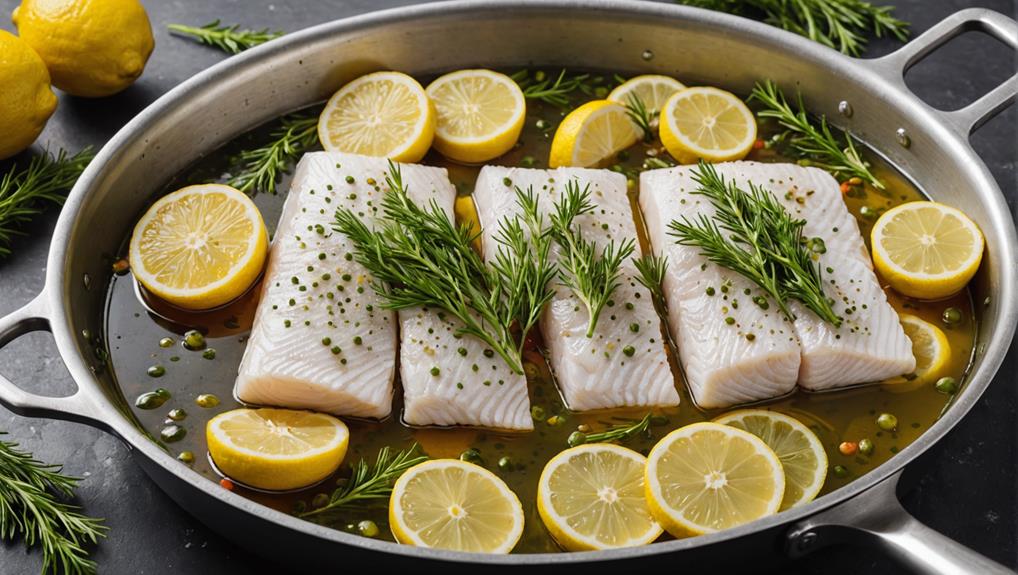
To elevate your poached fish's flavor profile, you'll want to infuse your poaching liquid with aromatic herbs.
Consider using dill, tarragon, or parsley, which can impart subtle yet distinctive flavors to your dish.
For an extra layer of complexity, try adding citrus zest to the mix, such as lemon or orange, which will brighten the overall taste and complement the fish's natural flavors.
Infusing Aromatic Herbs
The symphony of aromas elevates poached fish from simple to sublime. By infusing poaching liquid with aromatics, you're not just cooking; you're crafting a sensory experience. Fresh herbs like thyme, dill, and tarragon are your secret weapons, imparting delicate flavors that enhance the fish's natural taste.
Much like the seasonal vegetables used in Harvest Vegetable Soup, incorporating fresh, local ingredients can make a significant difference in flavor. Don't stop there—experiment with spices and citrus to create a complex flavor profile that'll tantalize your taste buds.
When selecting aromatics, consider the type of fish you're poaching:
- Lighter fish: Opt for subtle flavors like lemon zest and dill
- Medium-bodied fish: Try a combination of thyme and garlic
- Rich, oily fish: Go bold with bay leaves and peppercorns
To build a robust flavor base, combine your chosen aromatics with vegetables like onions, carrots, or celery in broth or wine. This innovative approach transforms your poaching liquid into a flavorful elixir that infuses every fiber of the fish.
As you master this technique, you'll discover endless possibilities for creating unique, aromatic dishes that showcase your culinary prowess and elevate your fish-poaching game to new heights.
Citrus Zest Enhancement
While aromatics like herbs and spices can elevate your poached fish, citrus zest adds a bright, refreshing dimension that shouldn't be overlooked.
This innovative cooking technique harnesses the power of aromatic oils found in citrus peels to infuse your fish with subtle, fragrant notes that enhance its natural flavor.
To maximize the impact, combine a teaspoon of citrus zest per cup of poaching liquid with complementary herbs like dill or tarragon and spices such as black pepper. This creates a well-rounded flavor profile that'll transform your poached fish into a culinary masterpiece.
For optimal results, use fresh zest from organic citrus fruits to avoid pesticide residues and capture the brightest flavors.
When incorporating citrus zest into your poaching liquid, you'll notice a delicate balance of flavors that doesn't overpower the fish.
This technique is particularly effective with delicate white fish varieties, as it enhances their mild taste without masking it.
Plating Techniques for Poached Fish
Plating poached fish is an art form that elevates your culinary creation from a simple meal to a visually stunning dish.
Begin by selecting a clean, white plate to showcase your perfectly poached piece of fish. Place the fish in the center, using a spatula to ensure it remains intact. This central positioning draws the eye and highlights the delicate texture of your masterpiece.
To enhance the visual appeal, consider these innovative plating techniques:
- Garnish with finely chopped herbs like dill or parsley for a pop of color
- Drizzle a light sauce or vinaigrette around the fish, not over it
- Arrange poached vegetables artistically alongside the fish
These elements create a harmonious balance of colors and textures, transforming your plate into a canvas.
Remember, the goal is to maintain the pristine appearance of your poached fish while adding complementary flavors and visual interest.
Adjusting Cooking Time for Portions
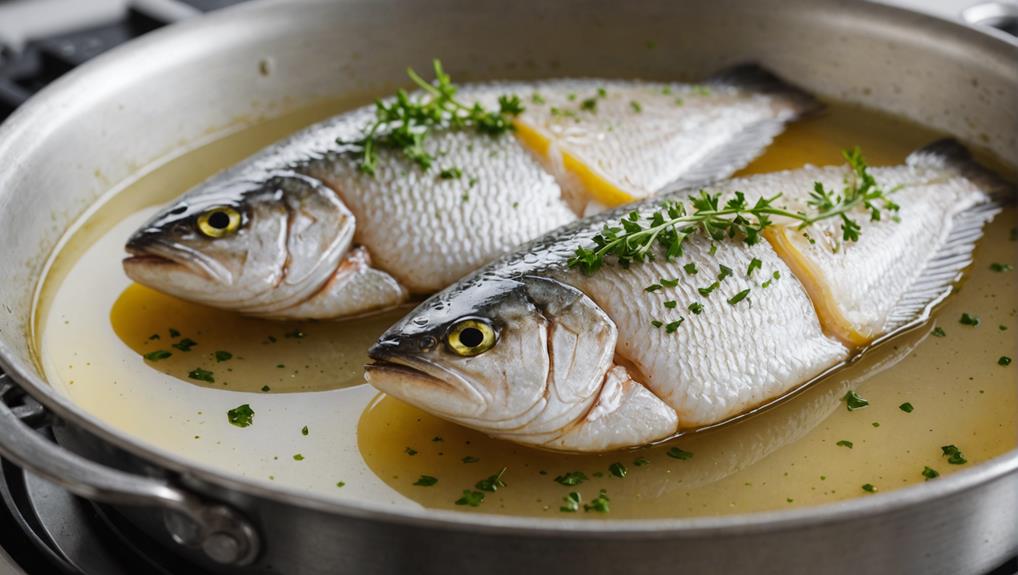
Mastering the art of poaching fish requires precise timing, especially when adjusting for different portion sizes. When using water as your poaching liquid, you'll need to adapt your cooking times based on the thickness and weight of your fish portions. For standard six-ounce pieces, aim for 8-10 minutes of cooking time.
However, if you're working with thicker cuts, you'll want to increase the duration by 2-3 minutes for every additional half-inch of thickness. To ensure optimal doneness, regardless of size, use a thermometer to check the internal temperature. You're aiming for 135°F to 140°F for perfectly poached fish.
For smaller, more delicate fillets under an inch thick, reduce your cooking time to just 4-5 minutes to maintain their tender texture. Keep in mind that when poaching multiple pieces simultaneously, you may need to extend the cooking time slightly due to heat distribution changes.
Always monitor your poaching liquid closely and be prepared to adjust your timing as needed. By mastering these time adjustments, you'll consistently achieve flawlessly poached fish, elevating your culinary skills to new heights.
Frequently Asked Questions
What Is the Poaching Technique in Cooking?
You'll love poaching for its gentle simmering technique. It's a culinary innovation that enhances flavor infusion. You submerge food in liquid at low temperatures, preserving delicate textures and nutrients. It's perfect for fish, poultry, and more.
Why Is It Important to Only Poach Fish?
Like a gentle caress, poaching fish isn't just important, it's revolutionary. You'll unlock health benefits, preserve delicate flavors, and maintain moisture. It's your gateway to innovative cooking, ensuring tender, nutrient-rich meals that'll wow your taste buds.
What Is a Fish Poacher in Culinary?
You'll love a fish poacher, an innovative kitchen tool designed for simmering fish. It's a long, narrow vessel with a lid and often a perforated insert. You'll achieve perfectly poached fish every time with this specialized equipment.
What Is Poaching Techniques?
Dive into the world of poaching techniques! You'll gently simmer fish in flavored liquid, maintaining low temperatures for tender results. It's a fat-free method that's all about flavor infusion, creating innovative, moist dishes you'll love.
Final Thoughts
You've now mastered the art of poaching fish, a technique that's not only healthy but also incredibly versatile. Did you know that poaching can reduce a fish's fat content by up to 50%? This method allows you to create flavorful, tender dishes while maintaining the fish's nutritional value. Remember, practice makes perfect. As you refine your skills, you'll discover endless possibilities for creating delicious, perfectly poached fish dishes that will impress family and friends alike.

